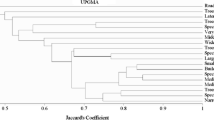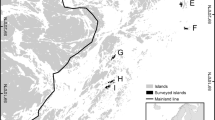Abstract
The evaluation of species and structural diversity of home gardens strongly depends on the methods used. We distinguish the biosocial and the bionumerical method. The first is widely used and takes data of the whole population of trees of home gardens to calculate diversity. The bionumerical method calculates diversity from data of a fixed number of randomly selected trees. We apply both methods to analyze if structural and species diversity varies with home garden size, a theme of considerable conservation interest, and compare results. We inventoried the tree component of a sample of 61 home gardens from rural areas in Tabasco, Mexico, which we assigned to three size categories: small (≤1,000 m2), medium sized (>1,000 and ≤2,000 m2), and large home gardens (>2,000 m2). Average species richness and Shannon diversity indices determined by the biosocial method were significantly different among home garden size classes. Average species richness determined by the bionumerical method did not differ among size classes. Both methods showed highest total observed and estimated species richness in the large home gardens, which contain many unique species. Both methods showed similar overall species composition among size classes and highest structural diversity in large home gardens. We conclude that it is important for conservation to maintain large home gardens in local mosaics, and that the biosocial and bionumerical methods are complementary. The bionumerical method allows straight comparison of population diversity within and among systems, but lacks attention for rare and unique species. The biosocial method evaluates how much diversity families custody.





Similar content being viewed by others
References
Abebe T, Wiersum KF, Bongers F (2010) Spatial and temporal variation in crop diversity in agroforestry homegardens of southern Ethiopia. Agrofor Syst 78:309–322
Albuquerque UP, Andrade LHC, Caballero J (2005) Structure and floristics of homegardens in Northeastern Brazil. J Arid Environ 62:491–506
Beukema H, Danielsen F, Vincent G, Hardiwinoto S, Andel JV (2007) Plant and bird diversity in rubber agroforests in the lowlands of Sumatra, Indonesia. Agrofor Syst 70:217–242
Bhagwat SA, Willis KJ, Birks JB, Whittaker RJ (2008) Agroforestry: a refuge for tropical biodiversity? Trends Ecol Evol 23:261–267
Blanckaert I, Swennen RL, Paredes-Flores M, Rosas-López R, Lira-Saade R (2004) Floristic composition, plant uses and management practices in home gardens of San Rafael Coxcotlaán, Valle of Tehuacán-Cuicatlán, Mexico. J Arid Environ 57:179–201
Casas A, Vázquez M, Viveros J, Caballero J (1996) Plant management among the Nahua and the Mixtec in the Balsas River Basin, Mexico: an ethnobotanical approach to the study of plant domestication. Human Ecol 24:455–478
Chappell MJ, LaValle LA (2011) Food security and biodiversity: can we have both? An agroecological analysis. Agric Hum Values 28:3–26
Colwell RK (2006) EstimateS: statistical estimation of species richness and shared species from samples. Version 8.0. SUFE, Shanghai
Colwell RK, Coddington JA (1994) Estimating territorial biodiversity through extrapolation. Philos Trans Biol Sci 345:101–118
Das T, Das AK (2005) Inventorying plant biodiversity in home gardens: a case study in Barak Valley, Assam, North East India. Curr Sci (Bangalore) 89:155–163
Engels JMM (2002) Home gardens—a genetic resource perspective. In: Watson JW, Eyzaguirre PB (eds) Proceedings of the second international home garden workshop. Bioversity International, Rome, pp 3–9
Fernandes ECM, Nair PKR (1986) An evaluation of the structure and function of tropical home gardens. Agric Syst 21:279–310
Gajaseni J, Gajaseni N (1999) Ecological rationalities of the traditional homegarden system in the Chao Phraya Basin, Thailand. Agrofor Syst 46:3–23
Galluzzi G, Eyzaguirre PB, Negri V (2010) Home gardens: neglected hotspots of agro-biodiversity and cultural diversity. Biodiv Conserv 19:3635–3654
Goddard MA, Dougill AJ, Benton TG (2009) Scaling up from gardens: biodiversity conservation in urban environments. Trends Ecol Evol 25:90–98
Gordon C, Manson R, Jeffrey S, Cruz-Angón A (2007) Biodiversity, profitability, and vegetation structure in a Mexican coffee agroecosystem. Agric Ecosyst Environ 118:256–266
Gotelli NJ, Colwell RK (2001) Quantifying biodiversity: procedures and pitfalls in the measurement and comparison of species richness. Ecol Lett 4:379–391
Gotelli NJ, Entsminger GL (2011) EcoSim: null models software for ecology. Acquired Intelligence Inc. & Kesey-Bear, Jericho
Hammer Ø, Harper DAT, Ryan PD (2001) PAST: paleontological statistics software package for education and data analysis. Palaeontol Electron 4:1–9
Harvey CA, Gonzalez-Villalobos JA (2007) Agroforestry systems conserve species-rich but modified assemblages of tropical birds and bats. Biodiv Conserv 16:2257–2292
Hughes JB, Daily GC, Ehrlich PR (2002) Conservation of tropical forest birds in countryside habitats. Ecol Lett 5:121–129
Imbruce V (2007) Bringing Southeast Asia to the Southeast United States: new forms of alternative agriculture in Homestead, Florida. Agric Hum Values 24:41–59
Jose D, Shanmugaratnam N (1993) Traditional homegardens of Kerala: a sustainable human ecosystem. Agrofor Syst 24:203–213
Kehlenbeck K, Arifin H, Maass B (2007) Plant diversity in homegardens in a socio-economic and agro-ecological context. In: Teja Tscharntke, CL, Manfred Zeller, Edi Guhardja and Arifuddin Bidin (eds) Stability of tropical rainforest margins linking ecological, economic and social constraints of land use and conservation. Springer, Berlin, pp 297–319
Kimber CT (1973) Spatial patterning in the Dooryard gardens of Puerto Rico. Geogr Rev 63:6–26
Kumar BM, Nair PKR (2004) The enigma of tropical homegardens. Agrofor Syst 61:135–153
Kumar BM, George SJ, Chinnamani S (1994) Diversity, structure and standing stock of wood in the homegardens of Kerala in peninsular India. Agrofor Syst 25:243–262
Lawton JH, Bignell DE, Bolton B, Bloemers GF, Eggleton P, Hammond PM, Hodda M, Holt RD, Larsen TB, Mawdsley NA, Stork NE, Srivastava DS, Watt AD (1998) Biodiversity inventories, indicator taxa and effects of habitat modification in tropical forest. Nature 391:72–76
Moreno-Black G, Somnasang P, Thamathawan S (1996) Cultivating continuity and creating change: women’s home garden practices in northeastern Thailand. Agric Hum Values 13:3–11
Padoch C, De Jong W (1991) The house gardens of Santa Rosa: diversity and variability in an Amazonian agricultural system. Econ Bot 45:166–175
Perfecto I, Vandermeer J (2008) Biodiversity conservation in tropical agroecosystems. Ann N Y Acad Sci 1134:173–200
Peyre A, Guidal A, Wiersum KF, Bongers F (2006) Dynamics of homegarden structure and function in Kerala, India. Agrofor Syst 66:101–115
Reitsma R, Parrish JD, McLarney W (2001) The role of cacao plantations in maintaining forest avian diversity in southeastern Costa Rica. Agrofor Syst 53:185–193
Rico-Gray V, Garcia-Franco JG, Chemas A, Puch A, Sima P (1990) Species composition, similarity, and structure of Mayan homegardens in Tixpeual and Tixcacaltuyub, Yucatan, Mexico. Econ Bot 44:470–487
Scales BR, Marsden SJ (2008) Biodiversity in small-scale tropical agroforests: a review of species richness and abundance shifts and the factors influencing them. Environ Conserv 35:160–172
Soemarwoto O, Conway GR (1991) The Javanese homegarden. J Farm Syst Res Ext 2:95–117
Sutherland WJ, Armstrong-Brown S, Armsworth PR, Brereton T, Brickland J, Campbell CD, Chamberlain DE, Cooke AI, Dulvy NK, Dusic NR, Fitton M, Freckleton RP, Godfray HC, Grout N, Harvey HJ, Hedley C, Hopkins JJ, Kift NB, Kirbey J, Kunin WE, Macdonald DW, Marker B, Naura M, Neale AR, Oliver T, Osborn D, Pullin AS, Shardlow MEA, Showler DA, Smith PL, Smithers R, Solandt J-L, Spencer J, Spray CJ, Thomas CD, Thompson J, Webb SE, Yalden DW, Watkinson AR (2006) The identification of 100 ecological questions of high policy relevance in the UK. J Appl Ecol 43:617–627
Van der Wal H, Huerta E, Torres A (2011) Huertos familiares en Tabasco. Elementos para una política integral en materia de ambiente, biodiversidad, alimentación, salud, producción y economía. SERNAPAM/El Colegio de la Frontera Sur, Villahermosa, p 121
Vandermeer J, van Noordwijk M, Anderson J, Ong C, Perfecto I (1998) Global change and multi-species agroecosystems: concepts and issues. Agric Ecosyst Environ 67:1–22
West RC, Psuty NP, Thom BG (1985) Las Tierras Bajas de Tabasco en el Sureste de México. Gobierno del Estado de Tabasco, p 409
Winkler-Prins AMGA, de Souza PS (2005) Surviving the city: urban home gardens and the economy of affection in the Brazilian Amazon. J Latin Am Geogr 4:107–126
Zaldivar ME, Rocha OJ, Castro E, Barrantes R (2002) Species diversity of edible plants grown in homegardens of Chibchan Amerindians from Costa Rica. Human Ecol 30:301–316
Zimmerer K (2007) Agriculture, livelihoods, and globalization: the analysis of new trajectories (and avoidance of just-so stories) of human–environment change and conservation. Agric Hum Values 24:9–16
Acknowledgments
The Ministry of Natural Resources and Environmental Protection (SERNAPAM) of Tabasco, Mexico, financed research through grants ACU-017-09 and DK-396, and the Mexican Consejo Nacional de Ciencia y Tecnología (CONACYT) through the project “Gestión y estrategias de manejo sustentable para el desarrollo regional en la cuenca hidrográfica transfronteriza Grijalva” (Grant number FORDECYT-143303) and sabbatical Grant number CONACYT-147619. Manuel Vargas Domínguez, Wilbert Santiago Poot Pool and Daniel Antonio Poot Pool conducted field work. Isidra Pérez Ramírez determined botanic names of voucher specimens. The Forest and Nature Conservation Policy Group at Wageningen University and Research in The Netherlands provided academic support and office facilities. We thank the owners of the home gardens in Tabasco, Mexico, for allowing the vegetation censuses.
Author information
Authors and Affiliations
Corresponding author
Rights and permissions
About this article
Cite this article
van der Wal, H., Bongers, F. Biosocial and bionumerical diversity of variously sized home gardens in Tabasco, Mexico. Agroforest Syst 87, 93–107 (2013). https://doi.org/10.1007/s10457-012-9526-4
Received:
Accepted:
Published:
Issue Date:
DOI: https://doi.org/10.1007/s10457-012-9526-4




